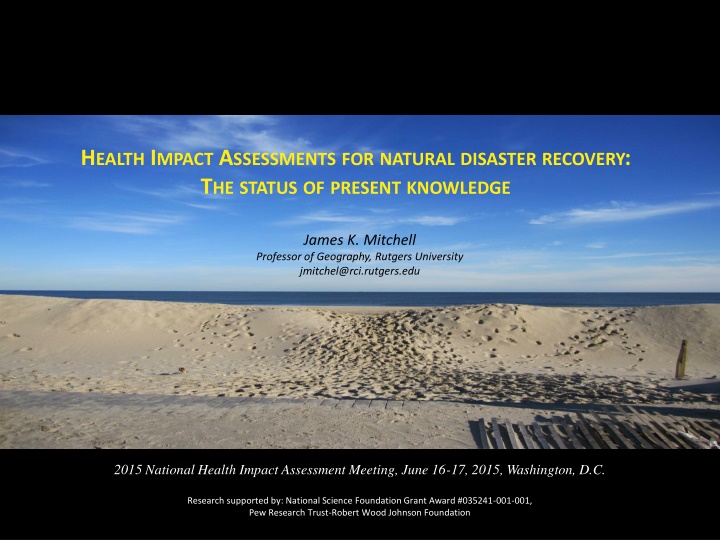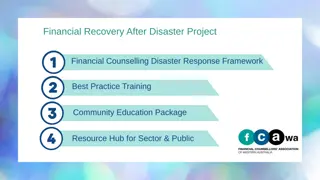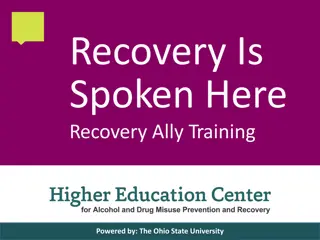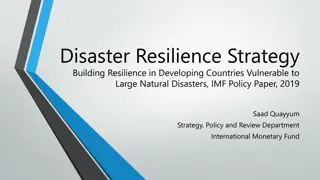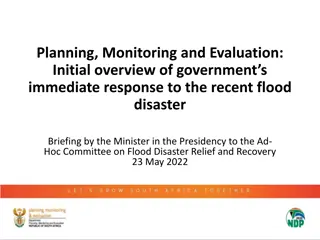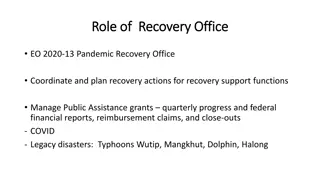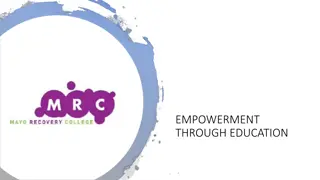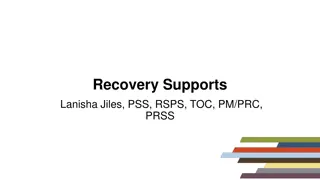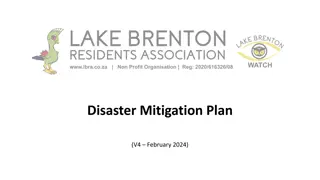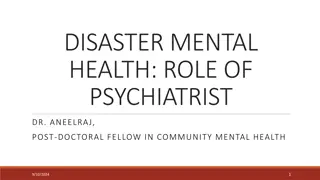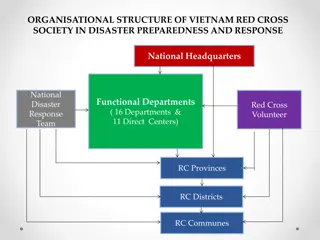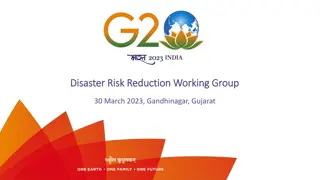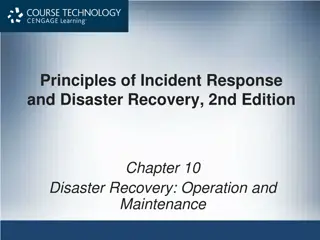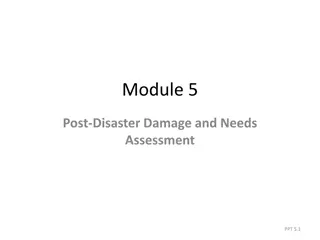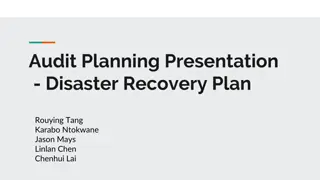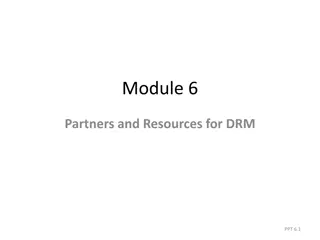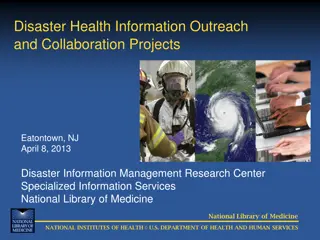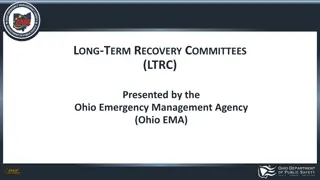Health Impact Assessments for Natural Disaster Recovery
The study examines the status of knowledge related to health impact assessments for natural disaster recovery, emphasizing the importance of considering the long-term health impacts of disasters. It highlights how disasters and recovery actions can have lasting consequences on community health and well-being, including physical and mental health, infrastructures, economies, and ecosystems. The research stresses the need for disaster recovery Health Impact Assessments (HIAs) to assess specific long-term recovery initiatives post-disaster and calls for better integration with hazard reduction efforts to mitigate future disasters effectively.
Download Presentation

Please find below an Image/Link to download the presentation.
The content on the website is provided AS IS for your information and personal use only. It may not be sold, licensed, or shared on other websites without obtaining consent from the author.If you encounter any issues during the download, it is possible that the publisher has removed the file from their server.
You are allowed to download the files provided on this website for personal or commercial use, subject to the condition that they are used lawfully. All files are the property of their respective owners.
The content on the website is provided AS IS for your information and personal use only. It may not be sold, licensed, or shared on other websites without obtaining consent from the author.
E N D
Presentation Transcript
HEALTH IMPACT ASSESSMENTSFORNATURALDISASTERRECOVERY: THESTATUSOFPRESENTKNOWLEDGE James K. Mitchell Professor of Geography, Rutgers University jmitchel@rci.rutgers.edu 2015 National Health Impact Assessment Meeting, June 16-17, 2015, Washington, D.C. Research supported by: National Science Foundation Grant Award #035241-001-001, Pew Research Trust-Robert Wood Johnson Foundation
DISASTERS AND RECOVERY ACTIONS HAVE CONSEQUENCES FOR FUTURE HEALTH Health Impacts PROMPT: Deaths; injuries; overtaxed emergency healthcare delivery systems DELAYED: Undermining of community wellbeing via lasting impacts on mental (as well as physical) health, infrastructures, economies and ecosystems Recovery without mitigation invites repetitions of disaster Current practice prioritizes speed over improved protection & better health outcomes Numbers of U.S. designated disasters are increasing 1953-2014: long term average of 60 per year 2011: 242 (99 Major Disasters; 29 Emergencies; 114 Fire Management declarations) Many other events not designated disasters but locally devastating Worsening climate risks expected to increase disasters
DISASTER RECOVERY HIAs Carried out in aftermath of disasters for purpose of assessing specific (long term) recovery initiatives Do not confuse with HIAs for emergency (short term) relief Raise issues that challenge the design, operation and interpretation of the existing HIA process and underline need for linkage with parallel hazard reduction efforts
DISASTER DIMENSIONS OF EXISTING HIAs 350+ ongoing/completed HIAs (mid-2015) Natural hazards generally ignored Reviewers point out hazards omissions Hermosa Beach, CA oil drilling project omitted climate change risks Coachella Valley, CA ignored flood risks to proposed developments Hawaii County, HA agricultural development plan ignored natural disasters A few HIAs make recommendations that strengthen short-term responses to hazards Emergency Preparedness Plan (Billings, MT) Denial of permit for facility that hindered emergency evacuation (Bernalillo County, NM) Rejection of county plan that hindered emergency evacuation (Merced County, CA) In the 20 or so HIAs that address natural hazard reduction directly, most focus on mitigation of chronic low intensity problems (e.g. routine flooding) Just 3 HIAs focus on recovery from catastrophic events (major floods, hurricanes)
GOAL HIA LOCATION LINKAGE TO DISASTER REDUCTION Recovery Galveston, TX Replacement of housing destroyed by hurricane Ike Recovery Little Egg Harbor, NJ Buyout scenarios for properties affected by hurricane Sandy Recovery Hoboken, NJ Post-Sandy comprehensive storm water management plan Mitigation Cana Martin, PR Dredging and sewer projects in chronically flood prone area Mitigation Proctor Creek, Atlanta, GA Green infrastructure in chronically flood prone area Mitigation Cole Creek, Omaha, NE Use of vacant lots created by flood buyouts & erosion control Mitigation Ann Arbor, MI Urban forestry as aid to high temperature reduction Mitigation Delaware County, OH Storm water runoff control from new shopping mall Mitigation Marin County, CA Housing code enforcement in poor drainage area Mitigation Rochester, NY Changes in lakefront storm water management Mitigation Chicago, IL Smart power cutoffs to elderly during cold/heat extremes Mitigation Placer County, CA Healthy forest management for reduction of wildfire risk Mitigation Greenville, WI Ground water contamination from hazardous material storage Mitigation Fitchburg, WI Flood reduction in vicinity of golf course Mitigation State of Kentucky Clean energy in mined area subject to landslides and floods Mitigation State of California Drinking water alternatives in drought affected areas Preparedness Various CA counties Earthquake effects in San Francisco Bay area
VARIED EXPERIENCES OF RECOVERY HIAS Galveston, TX: post-hurricane (Ike, 2008) redevelopment projects Negative health effects of disaster recovery program; too many actors/funding complications/increased awareness but divided vision San Juan, Puerto Rico: mitigation of chronic flooding Better health outcomes but sub-optimal flood relief structures; failure to acknowledge sustainable non-structural alternatives Atlanta, GA: mitigation of chronic flooding Green infrastructure, storm water management, economic regeneration linked with EPA regulatory process; recommended for scaling up Canterbury, New Zealand: earthquake(s) (2010-11) recovery After devastating quakes, HIAs that previously had ignored hazards included them and became embedded in a powerful comprehensive recovery strategy
DISASTER RECOVERY HIAs ARE DIFFERENT FROM OTHER TYPES OF HIAS OBJECTIVES Dual agendas: improve health and reduce hazards/disasters CONTEXT Experimental: Convergence of different expert communities and stakeholders Expedient: Actions not previously planned; time sensitive Extraordinary: Normal roles/cues/performance expectations may not apply Emergent: New actors; evolving institutional arrangements SIGNIFICANT POTENTIAL FOR AFFECTING CHANGE Neglected opportunities Large pool of recovery decisions; far-reaching consequences, poorly assessed Enhanced use of local vernacular knowledge can transform decision-making
A POST-SANDY STORM SURGE POLICY/MANAGEMENT DILEMMA Recovery depends on cooperation of disaster affected residents Public recovery decisions are heavily influenced by NFIP guidance re: rebuilding NFIP guidance doesn t take account of many damage-forcing factors Residents are aware of, & informed about, NFIP neglected risk factors Residents face a complex web of (short-term, personal) recovery decisions that keep them from engaging with (long term, public) community recovery issues Residents experiences and valuable risk knowledge are disconnected from the recovery planning process Need for a decision support tool for assessing the consequences of long term recovery alternatives that facilitates inputs from local residents and is sensitive to local knowledge as well as expert knowledge
LIKELY RECEPTIVITY OF U.S. DISASTER RECOVERY SYSTEM TO HIAs Existing system of hazard management is decentralized and fragmented; organized around tiered structure with federal government providing leadership, research and strategic guidance across many agencies; states doing much of the detailed policy making/facilitation, and localities responsible for implementation. Ongoing efforts to integrate several different National Planning Frameworks emphasize top-down, federally driven initiatives Prevention Protection Mitigation Response Recovery HIAS should be attractive to hazards management community because of their holistic, integrative character and bottom-up perspective
WHERE WE ARE NOW Review of literature & experience (completed) Ongoing Recovery HIAs Little Egg Harbor, NJ Hoboken, NJ Thought Leader Meetings Health (March 2015) HIA (June 2015) Hazards (July 2015)
